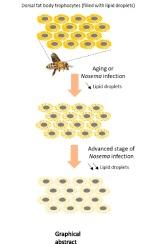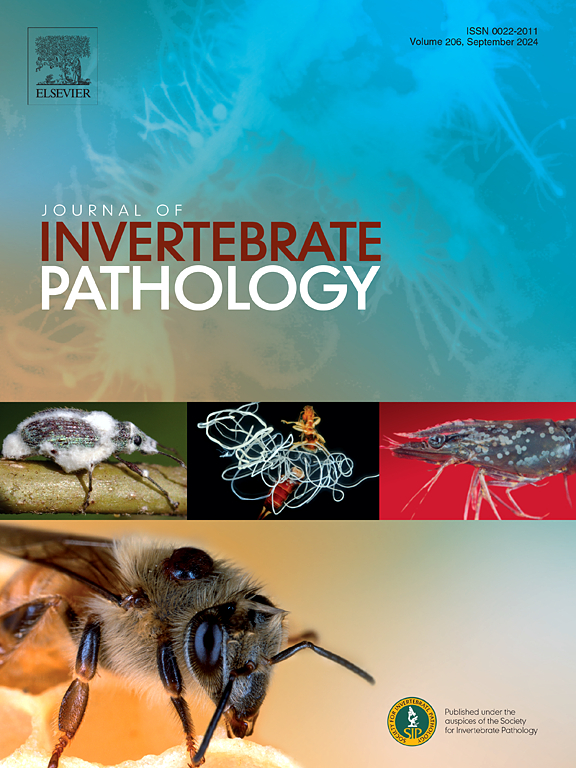陶瓷鼻疽瘤病毒感染会减少蜜蜂体内的脂质储备。
IF 2.4
3区 生物学
Q1 ZOOLOGY
引用次数: 0
摘要
陶氏野孢子虫(Nosema ceranae)是一种经常在蜂群中发现的肠道寄生虫。这种寄生虫属于小孢子虫,是一类已知强烈依赖宿主获取能量和资源的强制性胞内寄生虫。先前的研究表明,N. ceranae 可改变几种新陈代谢途径,包括参与营养储存的途径。为了探索神经鞘螨对脂肪体储备的影响,我们对新萌发的夏蜂进行了实验性感染,并测量了(1)接种后 2、7 和 14 天腹部脂肪体的脂质百分比(p.i.采用二乙醚脂质提取法测定腹部脂肪体的脂质百分比;(2) 采用分光光度法测定甘油三酯和蛋白质的浓度;(3) 采用尼罗河红染色法测定接种后 14 天和 21 天滋养层细胞内脂滴的数量。比较三种评估脂质储存的方法,我们的数据显示,尼罗河红染色法似乎是最简单、快速和可靠的方法。我们的结果首先表明,受感染蜜蜂的脂肪体脂质百分比在出生后第 14 天显著下降,蛋白质储存似乎未受感染影响,而甘油三酯浓度在出生后第 14 天下降了 30%,脂滴数量下降了 50%。本文章由计算机程序翻译,如有差异,请以英文原文为准。

Nosema ceranae infection reduces the fat body lipid reserves in the honeybee Apis mellifera
Nosema ceranae is an intestinal parasite frequently found in Apis mellifera colonies. This parasite belongs to Microsporidia, a group of obligate intracellular parasites known to be strongly dependent on their host for energy and resources. Previous studies have shown that N. ceranae could alter several metabolic pathways, including those involved in the nutrient storage. To explore the impact of N. ceranae on the fat body reserves, newly emerged summer bees were experimentally infected, and we measured (1) the lipid percentage of the abdominal fat body at 2-, 7- and 14-days post-inoculation (p.i.) using diethyl ether lipid extraction, (2) the triglyceride and protein concentrations by spectrophotometric assay methods, and (3) the amount of intracellular lipid droplets in trophocytes at 14- and 21-days p.i. using Nile Red staining. Comparing the three methods used to evaluate lipid stores, our data revealed that Nile Red staining seemed to be the simplest, fastest and reliable method. Our results first revealed that the percentage of fat body lipids significantly decreased in infected bees at D14 p.i. The protein stores did not seem to be affected by the infection, while triglyceride concentration was reduced by 30% and lipid droplet amount by 50% at D14 p.i. Finally, a similar decrease in lipid droplet reserves in response to N. ceranae infection was observed in bees collected in fall.
求助全文
通过发布文献求助,成功后即可免费获取论文全文。
去求助
来源期刊
CiteScore
6.10
自引率
5.90%
发文量
94
审稿时长
1 months
期刊介绍:
The Journal of Invertebrate Pathology presents original research articles and notes on the induction and pathogenesis of diseases of invertebrates, including the suppression of diseases in beneficial species, and the use of diseases in controlling undesirable species. In addition, the journal publishes the results of physiological, morphological, genetic, immunological and ecological studies as related to the etiologic agents of diseases of invertebrates.
The Journal of Invertebrate Pathology is the adopted journal of the Society for Invertebrate Pathology, and is available to SIP members at a special reduced price.

 求助内容:
求助内容: 应助结果提醒方式:
应助结果提醒方式:


